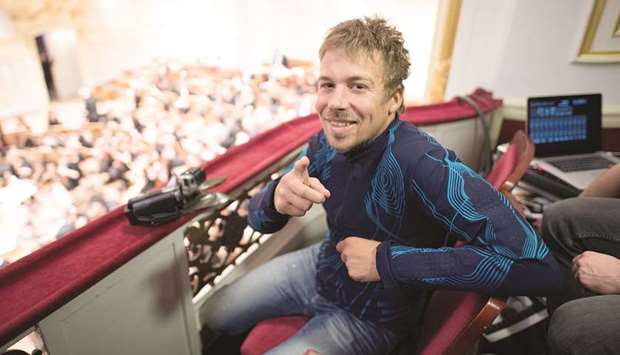That’s partly because concerts are not really aimed at people like her: Weyel has been hearing impaired since birth. But she’s about to experience the concert through a wearable device known as a ‘Sound Shirt.’
Weyel was chosen from hundreds of people who applied for the chance to try out the device, created by London-based fashion company CuteCircuit.
The ‘Sound Shirt’ is a tight-fitting blue jacket made of synthetic fibres and containing 16 tiny motors. The shirt processes sounds through eight microphones and converts them into vibrations.
The person wearing it feels the different sounds as different types of vibration, in different areas - whether it’s the violin on their chest and upper arm, or the percussion in their lower back.
For the past year and a half, the world’s only ‘Sound Shirt’ prototype has been undergoing tests with the Junge Symphoniker Hamburg, an amateur orchestra founded in 2001. The aim is to make the shirt as good as it can be.
“It’s totally exciting,” Weyel says in sign language after being welcomed backstage by two members of the orchestra. She describes how she once attended a performance of the musical The Lion King, during which she held a balloon in her hands that would pick up vibrations from the music. But then, she could feel only the vibrations of the deeper notes.
For the hearing impaired, the process of engaging with sound is not an acoustic experience, but one that is predominantly physical.
As the orchestra, directed by Bruno Merse, begins playing the famous Nutcracker Suite, a smile spreads across Weyel’s face. In her seat in a special box, she begins swaying to the rhythm of the music.
At times she encourages her husband next to her, himself hearing-impaired, to put his hands on the individual vibration points of her shirt. Otherwise, she raptly follows the concert while holding his hand. In the interval, she gives a joyous thumbs-up, her face radiant. “I’m thrilled,” she says, communicating through a sign-language interpreter. “A wonderfully beautiful experience that I’d love to have again.”
Weyel has some ideas about how to improve the ‘Sound Shirt’. There could be a better differentiation between the high and low tones, she believes.
In the second half of the concert, a man from Hamburg, Mischa Gohlke, gets the chance to wear the ‘Sound Shirt’ for a performance of Tschaikovsky’s Symphony Number 4 in F minor - a work full of dynamic contrasts.
The 37-year-old, though strongly hearing-impaired, plays the guitar in his own band. He is also the initiator of an association called ‘Grenzen Sind Relativ’ (‘Boundaries Are Relative’) that advocates for an inclusive, integrated and sustainable society.
He believes the ‘Sound Shirt’ should be seen as an experiment in expanding sensory perception and communication. He takes in the concert calmly, with his eyes closed.
Afterwards, he says the device allowed him to feel a great deal more than playing in his band - an experience he describes as a kind of ‘sound porridge.’
He also says he can imagine further fine-tuning of the ‘Sound Shirt’ to help it absorb the music even more clearly.
Anika Bresser, a viola player and spokeswoman for the Junge Symphoniker Hamburg, agrees. “Our vision is to one day have several shirts to make available to the deaf,” she says.
To make that happen, some sponsorship may be necessary - the current shirt, costing 20,000 euros (24,000 dollars), is a gift from the Hamburg advertising agency Jung von Matt, the place where the idea for the project first came up. – DPA



